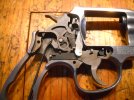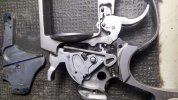Petrol & Powder
Well-Known Member
A friend picked up a slightly used S&W Model 64-8 and I performed a detail strip and inspection of that gun.
The dash 8 version of the old stainless K-frame is quite the departure from the traditional K-frame workhorse, but the basics are still there. If you’re old school like me, the internal lock, two-piece barrel and MIM parts cannot be ignored. But here’s what I believe to be a fair evaluation.
First, this was a used gun, but it had seen very little use. He didn’t pay a lot for it and it was in excellent condition. The timing was spot on, with no failure to carry up in SA or DA. There was no appreciable end shake. The ejector rod operation was smooth. Many of the parts have a slightly different form from the older models but they are well fitted. I didn’t measure the DA pull weight; however, it was smooth but very heavy.
The barrel to cylinder gap, measured with 6 empty casings in place, was exactly .006”. A .007” feeler gauge would not fit. The throats were checked with pin gauges, and they were all identical. A .357” + gauge would just barely pass, a .3575” + would not. From a fitting and assembly point of view, the revolver was very good.
Like all new S&W revolvers, it has a round butt grip frame. I guess this makes sense from a manufacturing perspective. Only one style is needed, and a square butt conversion grip can be installed if that’s desired. The factory grips were two pieces with some type of soft rubber molded onto a hard plastic inner shell. The grip screw has an exposed head on one side but threads into a brass ferrule embedded into the inner side of the opposite grip panel; it does not pass completely through the opposite grip. Not the best factory grips I’ve seen but far from the worst. The serial number on the butt of the grip frame is completely concealed by the grip but the same number is found on the frame under the yoke.
The overall finish on the gun was decent but the finish on the cylinder was excellent. In fact, the entire cylinder was machined very well with crisp, but not sharp edges and a fine finish. The extractor is a new style and was very finely fitted to the cylinder.
The screw that retains the yoke has the spring-loaded plunger, as is now the norm. The two remaining side plate screws appear to be identical, with a beveled edge on the screw head. This is a departure from the older screws that had a flat head for the screw under the grip and a slightly doomed head for the lower side plate screw. The holes in the side plate are counter sunk so that the flat head screw is no longer needed. This is one of the manufacturing changes made to reduce specialized parts.
The yoke is retained by the forward side plate screw as is normal but the cut in the yoke does not extend completely around the part. Once the side plate and yoke are removed from the frame, the departure from the older models is glaringly obvious. Almost none of the internal lock work is carried over from the prior versions. The hammer, DA sear, trigger, rebound slide, cylinder stop, bolt and some other parts are MIM parts. The firing pin is contained in the frame and is not attached to the hammer. There are cuts in the frame for the internal lock and the associated parts. The MIM parts showed no signs of being fitted and one would assume the tolerances of those parts “as made” don’t require fitting. Again, this is a concession to manufacturing and assembly.

The plunger/strut that interfaces the rebound slide to the trigger is a separate part and is loose in the trigger. It is captured between the trigger and rebound slide when assembled but this doesn’t look like a good idea to me.
The two-piece barrel utilizes an external shroud and an inner tensioned barrel. This undoubtedly simplifies assembly and fitting of the barrel. The shroud includes the front sight and under barrel lug. Because the shroud is keyed to the frame, there is no “clocking” issue with getting the front sight perfectly vertical during assembly. The barrel itself is in tension, like the old Dan Wesson switch barrels. After the barrel is inserted through the shroud and tightened, the only step left is to cut the breach face to achieve the proper barrel to cylinder gap.
Speaking of the breach face, there is no flat cut on the breach end to compromise the forcing cone, but the forcing cone does appear to be a bit thinner overall. Perhaps this is where better materials can be used for the inner barrel. S&W now uses an electro-chemical etching process to form the rifling. I do not have a bore scope but under some magnification the rifling appears to have a very smooth finish but the lands have slightly rounded edges. It’s not quite as sharply defined as traditional cut rifling, but the overall finish is excellent. A tight-fitting patch revealed zero choke in the bore.
The trigger face is smooth and rounded, this is a huge improvement over the old, serrated trigger face of some target models. If the gun will be shot predominately in DA, this is good thing.
Overall, the 64-8 is still a utilitarian, stainless steel, fixed sight, K-frame chambered for 38 Special.
The real world of business is harsh. Economic pressures are unforgiving and unwavering. S&W had a choice; they could find ways to reduce manufacturing costs, or they could increase prices and face the inevitable competition with those higher prices. Their very survival was dependent on the path they chose. The departures from the older versions are significant. Individuals will have to decide for themselves if they can tolerate the departure from traditional design and materials.
The dash 8 version of the old stainless K-frame is quite the departure from the traditional K-frame workhorse, but the basics are still there. If you’re old school like me, the internal lock, two-piece barrel and MIM parts cannot be ignored. But here’s what I believe to be a fair evaluation.
First, this was a used gun, but it had seen very little use. He didn’t pay a lot for it and it was in excellent condition. The timing was spot on, with no failure to carry up in SA or DA. There was no appreciable end shake. The ejector rod operation was smooth. Many of the parts have a slightly different form from the older models but they are well fitted. I didn’t measure the DA pull weight; however, it was smooth but very heavy.
The barrel to cylinder gap, measured with 6 empty casings in place, was exactly .006”. A .007” feeler gauge would not fit. The throats were checked with pin gauges, and they were all identical. A .357” + gauge would just barely pass, a .3575” + would not. From a fitting and assembly point of view, the revolver was very good.
Like all new S&W revolvers, it has a round butt grip frame. I guess this makes sense from a manufacturing perspective. Only one style is needed, and a square butt conversion grip can be installed if that’s desired. The factory grips were two pieces with some type of soft rubber molded onto a hard plastic inner shell. The grip screw has an exposed head on one side but threads into a brass ferrule embedded into the inner side of the opposite grip panel; it does not pass completely through the opposite grip. Not the best factory grips I’ve seen but far from the worst. The serial number on the butt of the grip frame is completely concealed by the grip but the same number is found on the frame under the yoke.
The overall finish on the gun was decent but the finish on the cylinder was excellent. In fact, the entire cylinder was machined very well with crisp, but not sharp edges and a fine finish. The extractor is a new style and was very finely fitted to the cylinder.
The screw that retains the yoke has the spring-loaded plunger, as is now the norm. The two remaining side plate screws appear to be identical, with a beveled edge on the screw head. This is a departure from the older screws that had a flat head for the screw under the grip and a slightly doomed head for the lower side plate screw. The holes in the side plate are counter sunk so that the flat head screw is no longer needed. This is one of the manufacturing changes made to reduce specialized parts.
The yoke is retained by the forward side plate screw as is normal but the cut in the yoke does not extend completely around the part. Once the side plate and yoke are removed from the frame, the departure from the older models is glaringly obvious. Almost none of the internal lock work is carried over from the prior versions. The hammer, DA sear, trigger, rebound slide, cylinder stop, bolt and some other parts are MIM parts. The firing pin is contained in the frame and is not attached to the hammer. There are cuts in the frame for the internal lock and the associated parts. The MIM parts showed no signs of being fitted and one would assume the tolerances of those parts “as made” don’t require fitting. Again, this is a concession to manufacturing and assembly.

The plunger/strut that interfaces the rebound slide to the trigger is a separate part and is loose in the trigger. It is captured between the trigger and rebound slide when assembled but this doesn’t look like a good idea to me.
The two-piece barrel utilizes an external shroud and an inner tensioned barrel. This undoubtedly simplifies assembly and fitting of the barrel. The shroud includes the front sight and under barrel lug. Because the shroud is keyed to the frame, there is no “clocking” issue with getting the front sight perfectly vertical during assembly. The barrel itself is in tension, like the old Dan Wesson switch barrels. After the barrel is inserted through the shroud and tightened, the only step left is to cut the breach face to achieve the proper barrel to cylinder gap.
Speaking of the breach face, there is no flat cut on the breach end to compromise the forcing cone, but the forcing cone does appear to be a bit thinner overall. Perhaps this is where better materials can be used for the inner barrel. S&W now uses an electro-chemical etching process to form the rifling. I do not have a bore scope but under some magnification the rifling appears to have a very smooth finish but the lands have slightly rounded edges. It’s not quite as sharply defined as traditional cut rifling, but the overall finish is excellent. A tight-fitting patch revealed zero choke in the bore.
The trigger face is smooth and rounded, this is a huge improvement over the old, serrated trigger face of some target models. If the gun will be shot predominately in DA, this is good thing.
Overall, the 64-8 is still a utilitarian, stainless steel, fixed sight, K-frame chambered for 38 Special.
The real world of business is harsh. Economic pressures are unforgiving and unwavering. S&W had a choice; they could find ways to reduce manufacturing costs, or they could increase prices and face the inevitable competition with those higher prices. Their very survival was dependent on the path they chose. The departures from the older versions are significant. Individuals will have to decide for themselves if they can tolerate the departure from traditional design and materials.
Last edited:

